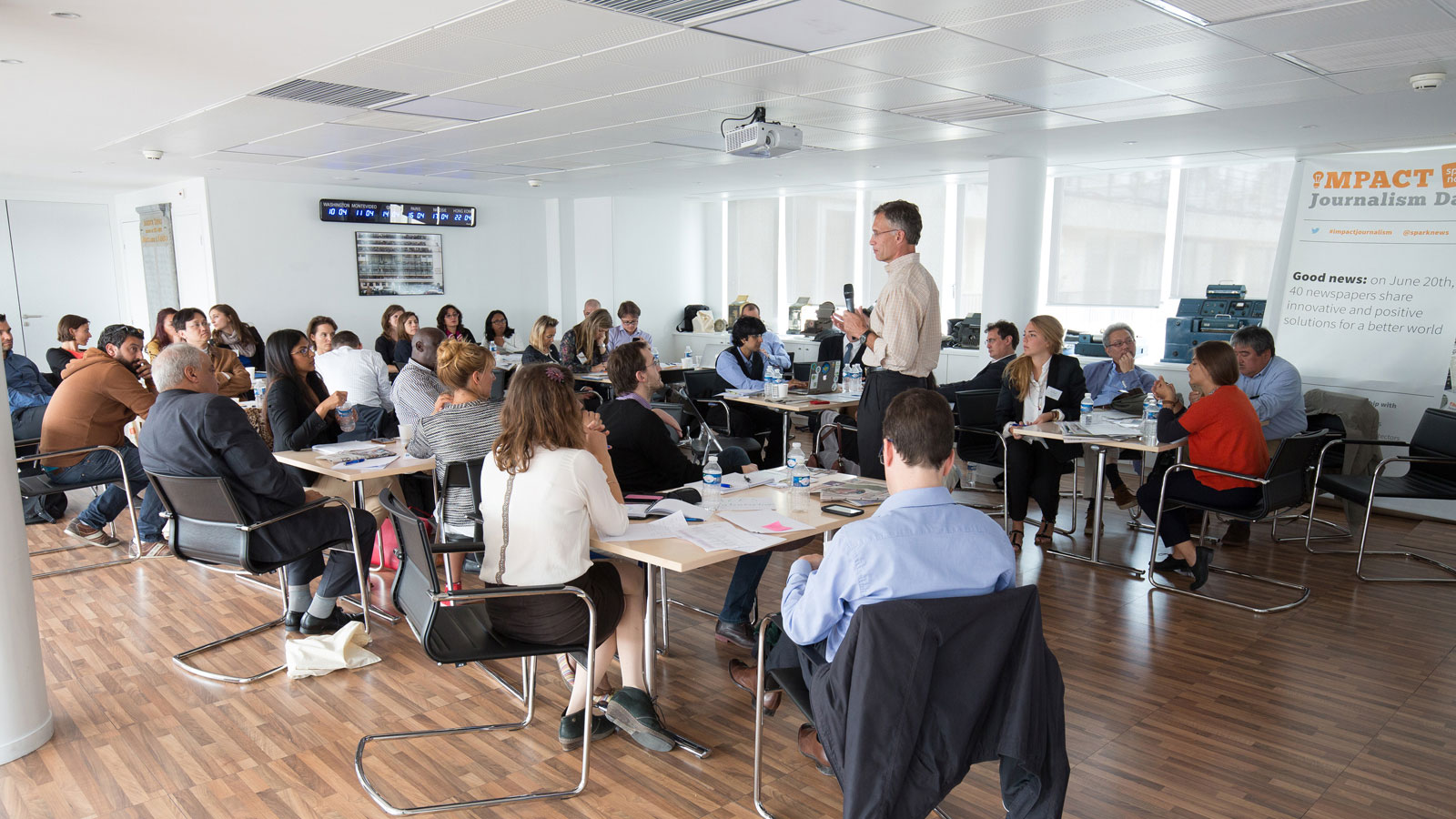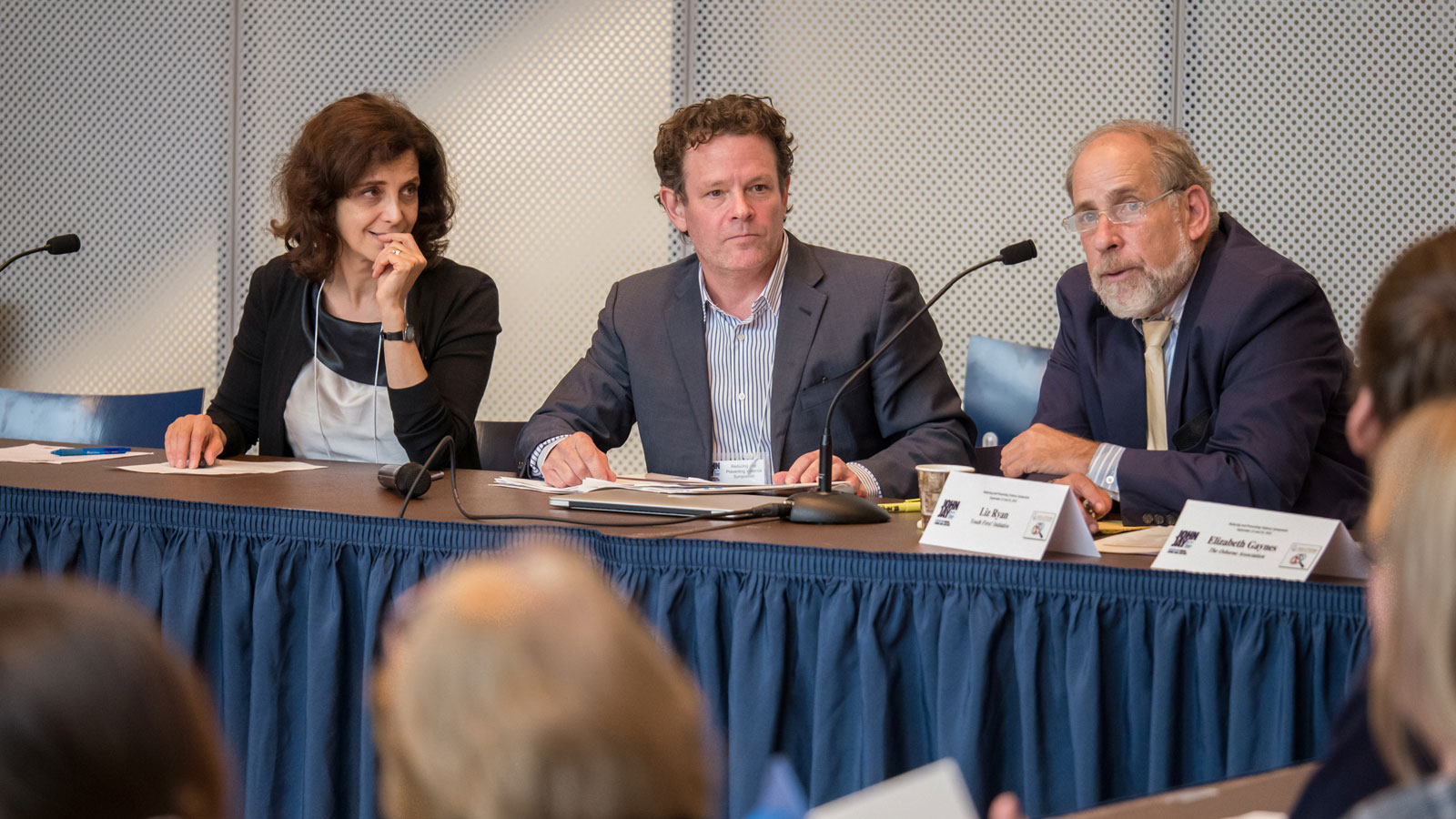Jeśli czytasz ten poradnik, to znaczy, że jesteś co najmniej zaintrygowany dziennikarstwem rozwiązań i tym, jak poprawić swój warsztat dziennikarski. Świetnie. Uważamy, że dziennikarze mogą dużo zyskać, gdy przyjrzą się reakcjom na problemy społeczne.
Wielu ciekawych historii nikt nie opisuje. Dlaczego? Dziennikarstwo nigdy nie traktowało poważnie reakcji na problemy obywatelskie jako tematu na materiał. Niektórzy reporterzy i redaktorzy obawiają się, że będą postrzegani jako rzecznicy lub pracownicy agencji PR, jeśli zaangażują się w jakieś kwestie społeczne. Tutaj, w Solutions Journalism Network (SJN), naszym zadaniem jest zmiana tego podejścia. Definiujemy dziennikarstwo rozwiązań jako skrupulatne i przekonujące relacjonowanie reakcji na problemy społeczne. To dziennikarstwo według najwyższych standardów tego zawodu.

Pracujemy już z siecią z ponad 170 redakcjami i tysiącami samozatrudnionych dziennikarzy, aby pokazać, że nie trzeba się obawiać dobrego jakościowo dziennikarstwa rozwiązań. Wręcz przeciwnie – jest ono ważnym, ale zbyt rzadko używanym narzędziem w kieszeni reportera.
SJN został założony przez dwójkę doświadczonych reporterów prowadzących rubrykę Fixes dla „New York Timesa” oraz przez Courtney E. Martin, dziennikarkę i pisarkę, która zaczynała karierę podczas gwałtownej ekspansji mediów internetowych. Cała trójka sporo podróżowała: zwiedzała farmy w Indiach, szpitale w Brazylii i dziewiąty okręg Nowego Orleanu – ten najmocniej zniszczony przez huragan Katrina. Te doświadczenia doprowadziły ich wszystkich do podobnego wniosku: nie ma wśród dziennikarzy wystarczająco dużo zdrowej rywalizacji o wspaniałe opowieści, które pokazywałyby reakcje na problemy społeczne na świecie.

Stary sposób myślenia: możliwe, że trzeba będzie pójść na kompromis z naszym profesjonalizmem, gdy piszemy o rozwiązaniach problemów społecznych. Nowy sposób myślenia: idziemy na kompromis z naszym profesjonalizmem, nie pisząc o rozwiązaniach problemów społecznych. Jesteśmy dziennikarzami i naszym zadaniem jest sprawić, aby społeczeństwo mogło przeglądać się w wiernie oddającym obraz lustrze. Jeśli nie potrafimy opisać wielu metod, za pomocą których ludzie i instytucje próbują rozwiązać problemy – skutecznie lub nie – nie wykonujemy naszych zadań. Na przykład: jeśli omawiamy tylko problemy systemowe w szkołach, a ignorujemy strategie, których celem jest poprawa stanu edukacji, nie opowiadamy całej historii.
Wielu z nas zostało dziennikarzami, ponieważ chcieliśmy mieć wpływ na świat, chcieliśmy uczynić go lepszym. Jednak opisywanie złych, błędnych zachowań nie jest jedynym sposobem na wywieranie wpływu. Ujawnianie problemów ma oczywiście kluczowe znaczenie, ale ten wpływ będzie większy, jeśli wraz z problemami będziemy informować o tym, jak ludzie je rozwiązują. Na przykład reporterzy zajmujący się edukacją tworzą bezkompromisowe artykuły o szkołach publicznych, które nie radzą sobie z problemem biedy wśród dzieci. Artykuły te miałyby większą siłę oddziaływania, gdyby również informowały, w jaki sposób szkoły kształcą swoich uczniów. Tego rodzaju historie aktywizują czytelników, słuchaczy i widzów. Zmieniają debatę publiczną. I zmieniają politykę.
Ludzie nie zmieniają się tylko dlatego, że ktoś zwraca uwagę na ich problemy. Musimy wiedzieć, że zmiana jest możliwa, i poznać wzory, które pokażą nam, jak to zrobić. Społeczeństwa działają według tej samej zasady.
Ten Learning Lab poświęcony dziennikarstwu rozwiązań jest przeznaczony dla każdego, kto chciałby ćwiczyć taki rodzaj dziennikarstwa. Mamy nadzieję, że znajdziesz tu wartościowe treści, niezależnie od tego, czy jesteś weteranem dziennikarstwa, który chce odświeżyć swoje metody, czy kamerzystą w średnim wieku pragnącym przypomnieć sobie powody, dla których został dziennikarzem. A może studentem dziennikarstwa chcącym zdefiniować swoją karierę lub jeszcze kimś innym.
Learning Lab przeprowadzi cię przez trening dziennikarstwa rozwiązań od samego początku, czyli od znalezienia rozwiązania problemu wartego podjęcia pracy dziennikarskiej, po ostatni krok – zaangażowanie czytelników w artykuł po jego opublikowaniu. Nie musisz jednak korzystać z tego materiału jak z tradycyjnej książki, czyli w kolejności od pierwszej do ostatniej strony. Możesz wybrać jedynie najbardziej przydatne rozdziały.
Wydobywamy struktury kilku artykułów dziennikarstwa rozwiązań, by pomóc ci w momentach, gdy nie będziesz miał weny pisarskiej. W pakiecie narzędziowym znajdziesz filmy i interaktywne ćwiczenia, które wprowadzają metodę rozwiązań w życie: linki do studium przypadków, przykładowych artykułów z naszego narzędzia do śledzenia artykułów rozwiązań (Solutions Story Tracker) oraz połączenia z innymi zasobami w naszym serwisie i nie tylko. Dodatkowo stworzyliśmy specjalne przewodniki dla dziennikarzy specjalizujących się w danej dziedzinie, które dotyczą zdrowia, edukacji i przemocy.
Ten Learning Lab traktujemy jako dokument roboczy i liczymy na odzew. Prześlij nam swoją opinię e-mailem, na Twitterze, możesz nawet wykorzystać skywriting. Czekamy na wszystkie rady, które pomogą nam ulepszyć ten materiał i sprawić, że będzie on bardziej przydatny dla rosnącej sieci osób zajmujących się dziennikarstwem rozwiązań.
Czekamy na wiadomości od was!
